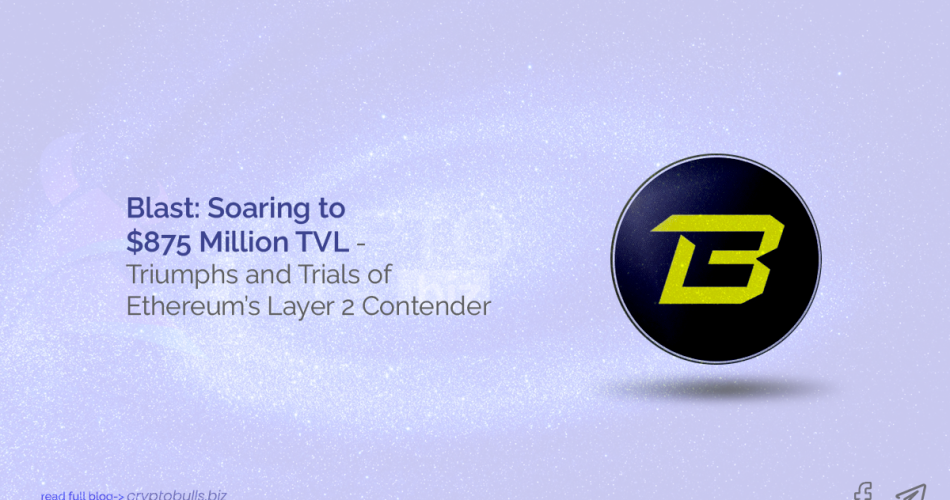Blast: Soaring to $875 Million TVL – Triumphs and Trials of Ethereum’s Layer 2 Contender
In the dynamic cosmos of blockchain technology, where innovation and controversy often go hand in hand, a new player has made an entrance that is as impressive as it is contentious. This newcomer is Blast, a Web3 protocol that has taken the crypto world by storm. Despite being a fresh entrant in the market, Blast has managed to amass a staggering ~$875 million in Total Value Locked (TVL) in a remarkably short span of time. This feat is not just a testament to Blast’s innovative approach, but also a reflection of the immense potential and trust that the crypto community sees in this protocol. However, the journey to this milestone has not been a smooth sail. From facing technical glitches to dealing with investor scrutiny, Blast’s voyage offers a fascinating insight into the challenges and triumphs of pioneering in the blockchain space.
The Meteoric Rise of Blast
Blast, a groundbreaking scaling solution for the Ethereum network, has been making waves in the crypto world with its swift and impressive growth. In just a week, it has seen a gain of 26.5%, a testament to its innovative approach and the trust it has garnered among its users.
Read about Blast – The Explosive Debut of Blast: Transformative Ethereum Layer 2 Solutions
The secret behind Blast’s rapid ascent lies in its unique business model that offers native yields to users who stake their funds. This model is a game-changer in the crypto space, promising a 4% yield on Ether (ETH) and a 5% yield on stablecoins. This lucrative offering has attracted a significant number of users to stake their funds in Blast, contributing to its exponential growth.
As of now, the total value locked in Ethereum through Blast stands at a whopping $875,390,980, accounting for 100% of the value. This is spread across various chains, with the wallet holding $15,275.
Among the chains, LIDO holds a significant portion with $770,487,474, while Maker trails behind with $104,888,275. These figures not only highlight the vast reach of Blast but also underscore its potential to transform the Ethereum network.
The Challenges and Controversies Surrounding Blast
While Blast’s rapid rise has been impressive, it has not been without its fair share of challenges and controversies. One of the most significant issues arose when a user staking on the protocol experienced a loss of $100,000 after converting a deposit to Dai (DAI). This unfortunate incident was attributed to a misconfigured slippage parameter on the user interface. In an attempt to rectify the situation, Blast compensated the user with $10,000, a gesture that, while commendable, highlighted the potential risks associated with the platform.
This incident sparked a wave of concern among users and investors alike, raising questions about the platform’s security measures and the robustness of its user interface. It served as a stark reminder of the inherent risks involved in the rapidly evolving world of crypto, where high returns often come hand in hand with high risks.
Investor Scrutiny
Blast’s relationship with its investor, Paradigm, has been a topic of intense scrutiny in recent times. Paradigm, a leading player in the crypto investment space, has raised concerns about Blast’s strategic decisions, particularly its decision to launch a bridge before its layer-2 network goes live.
Dan Robinson, the head of research at Paradigm, has been vocal about his disagreement with this strategy. According to Robinson, launching a bridge ahead of the layer-2 network could potentially expose the platform to unforeseen risks and challenges. This disagreement underscores the complexities and strategic considerations involved in developing and launching blockchain protocols.
However, despite these concerns and the ensuing scrutiny, Blast has managed to attract a significant user base. In just a few weeks since its launch, over 75,000 members have joined the platform, demonstrating their trust and confidence in Blast’s potential.
The Future
As we look towards the future, Blast has a roadmap that is as ambitious as it is promising. The team anticipates releasing its testnet and having a developer’s airdrop in January, marking the beginning of a new chapter in its journey. Following this, the mainnet should be available in February, a milestone that will significantly enhance the platform’s capabilities and offerings.
Despite the current lack of a withdrawal functionality, users depositing and staking on Blast have shown remarkable trust in the team. They believe that the team will add a withdrawal feature at some point in the coming months, further enhancing the platform’s user experience and functionality.
Looking at the broader picture, the upcoming months could be pivotal for Blast. With the crypto market showing signs of an impending bull run, there is a growing anticipation that Blast might cross the $1 billion mark in Total Value Locked (TVL) by the New Year. This would be a significant milestone, not just for Blast, but for the entire Ethereum Layer 2 landscape.
Conclusion
The journey of Blast serves as a compelling narrative in the dynamic world of blockchain technology. It’s a story of innovation, resilience, and potential. Despite the challenges and controversies, Blast’s meteoric rise to a staggering $875 million in Total Value Locked (TVL) is a testament to the transformative power of Ethereum’s Layer 2 solutions.
The road ahead for Blast is filled with promise. With the anticipated release of its testnet, developer’s airdrop, and mainnet, coupled with the potential of crossing the $1 billion mark in TVL amidst an upcoming bull run, Blast is poised to make significant strides in the crypto space.
As we wrap up, we leave you with this thought – Blast’s journey is not just about a new protocol making its mark. It’s about the relentless pursuit of innovation, the courage to face challenges head-on, and the unwavering belief in the potential of blockchain technology. As we continue to follow Blast’s journey, we look forward to bringing you more updates from the exciting world of Ethereum’s Layer 2 solutions


